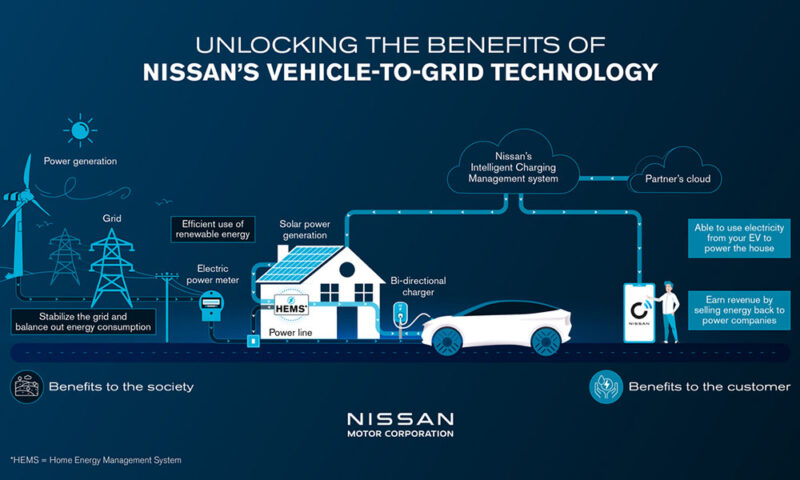
Technology to support transition to net zero and lower electricity bills
Nissan recently announced it will launch affordable on-board bi-directional charging on selected electric vehicles from 2026. The initiative forms a key step towards its vision of creating a sustainable energy ecosystem.
The project progresses the commitment made in Nissan’s business plan, The Arc, delivering differentiated innovation that enables the EV transition, while unlocking new revenue streams. It also supports the company’s long-term vision, Ambition 2030, to create a cleaner, safer, and more inclusive world.
The Vehicle to Grid (V2G) technology, which allows EV owners to use electricity stored in their car’s battery to power their homes, or sell it back into the grid, will launch in the UK initially, followed by other markets in Europe.
The project is underpinned by Nissan’s extensive experience in V2G, with around 40 pilot projects conducted worldwide throughout the past decade.
Crucial role
EVs equipped with V2G technology can play a crucial role in integrating and increasing the mix of renewables into the energy supply, by storing electricity generated by wind or solar, and directing it back into the grid when needed, reducing dependency on fossil fuels.
“The technology we are bringing to customers is a potential game-changer for how we view the car. Not just as a means of getting from A to B, but as a mobile energy storage unit, capable of saving people money, supporting the transition of our energy systems away from fossil fuels and bringing us closer to a carbon-free future,” observed Hugues Desmarchelier, Nissan Vice President, Global Electrification Ecosystem & EV Programmes.
“This is a significant milestone for the collaborative research and development project, led by Nissan Technical Centre Europe and supported by the Department for Business and Trade through the APC,” remarked Ian Constance, Chief Executive, APC.
“We are convinced that, by reducing the electricity bill for the customers while providing huge storage capabilities for the electrical system, V2x technology has a major role to play in the energy transition,” commented Eric Mévellec, CEO, Dreev.
Sustainable mobility solutions
“This test marks an important step in creating a sustainable, interconnected energy future where electric vehicles play a central role in sustainable mobility solutions and resolving energy grid congestions,” noted Bart Vereecke, CEO, Enovates.
“Enovates has always been committed to pushing the boundaries of V2G technology, and we are excited to bring our expertise in AC charging to this project. Our certified AC V2G chargers represent the next generation of energy technology, offering accessible, efficient, and smart solutions for the future of transportation and energy,” added Stijn Vispoel, R&D Manager.
“At Nissan, we see a future for our customers where their energy comes from the car on the driveway, not only the power station, fully integrated, flexible and cleaner,” stated Guillaume Cartier, Chairperson, Nissan’s Africa, Middle East, India, Europe and Oceania region.
